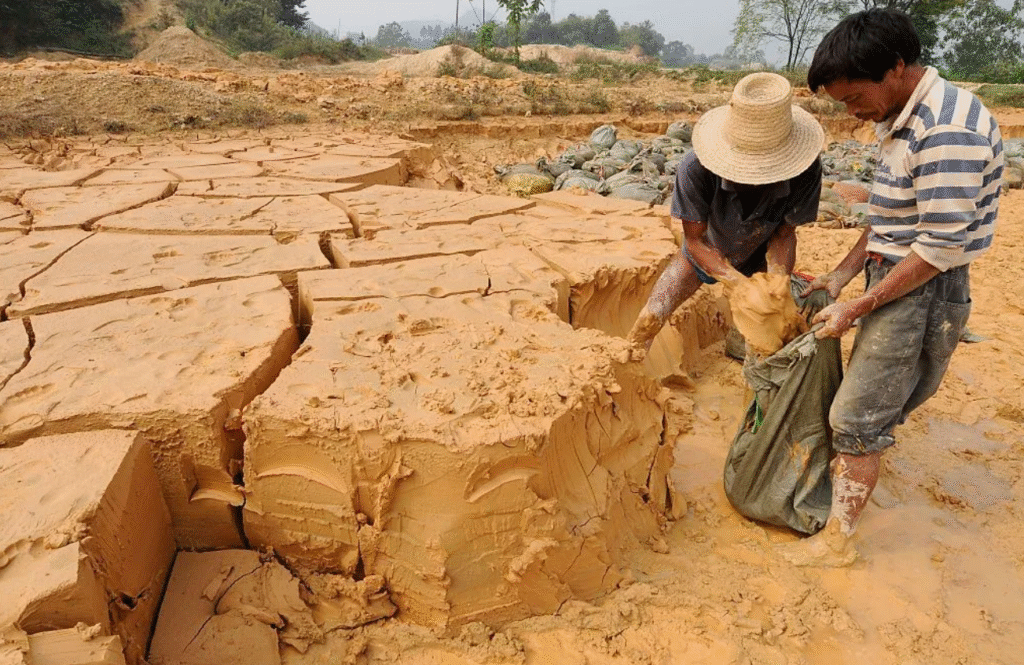Australia rare earth strategy is making headlines as the nation launches a billion-dollar bid to challenge China’s decades-long dominance in the rare earth minerals market. Deep in Western Australia’s Eneabba region, a vast pit of what appears to be ordinary dirt actually contains one of the world’s most valuable stockpiles of critical minerals, resources that power electric vehicles, wind turbines, and advanced defense technology.
For decades, China has controlled the global rare earth supply chain. But with growing geopolitical tensions and rising demand for clean energy technologies, Australia is stepping up to provide a secure, independent alternative.

Eneabba: From Barren Land to Australia Rare Earth Strategy
Three hours north of Perth lies Eneabba, a remote and largely desolate stretch of land. Beneath its dry surface sits over one million tonnes of rare earth-rich mineral sands, a byproduct of Iluka Resources’ zircon and titanium mining operations. While the mounds look unremarkable, they contain minerals like dysprosium and terbium, essential for producing high-performance magnets used in everything from smartphones to fighter jets.
This enormous stockpile, valued at more than $650 million, is now at the center of Australia rare earth strategy. With a A$1.65 billion ($1 billion USD) loan from the Australian government, Iluka Resources is building a state-of-the-art refinery to process these minerals domestically. Once operational, the facility aims to supply a significant portion of Western demand by 2030, reducing reliance on Chinese exports.
Why Rare Earths Matter
Despite the name, rare earths aren’t particularly scarce in nature. The challenge lies in processing them efficiently and sustainably. These 17 elements on the periodic table are lightweight, heat-resistant, and exceptionally strong, making them vital for small electric motors in EVs, renewable energy systems, and advanced weaponry.
An electric car can contain rare earth-based motors in dozens of components, from its speakers to its braking sensors. However, China currently mines over half of the world’s rare earths and processes nearly 90% of the global supply. The U.S. imports 80% of its rare earth needs from China, while the EU depends on Beijing for about 98% of its supply.
This monopoly became a geopolitical issue during the U.S.-China trade tensions, when China restricted exports. Automakers like Ford experienced production halts due to shortages, a stark reminder of how fragile the supply chain can be.
The West’s Long Game, and China’s Head Start
In the 1990s, Europe had a thriving rare earth industry, but investment waned as China aggressively expanded mining and refining capacity. Now, as nations race to secure these resources, rebuilding a competitive supply chain is costly and time-consuming.
Dan McGrath, Iluka’s head of rare earths, notes that Australia’s entry into the sector wasn’t initially part of its business model. The company’s existing mineral sands operations naturally produced rare earth-rich byproducts, but processing them requires complex chemical separation techniques, often producing radioactive waste.
This is where the government’s billion-dollar loan becomes pivotal. Without it, the economics of entering the rare earths refining industry wouldn’t make sense.
Australia Rare Earth Strategy: Building a Cleaner Alternative
One of Australia’s biggest selling points is its environmental standards. While China has faced criticism for pollution and weak regulation in rare earth processing, with reports of radioactive waste contaminating waterways, Australia promises to adhere to strict environmental controls.
Professor Jacques Eksteen of Curtin University points out that no mining industry is completely clean, but Australia has the legal and technical frameworks to manage waste responsibly. This could make its rare earth supply more attractive to global manufacturers aiming to meet sustainability goals.
Geopolitics and Supply Chain Security
Canberra views its investment in rare earths as a strategic necessity. Madeleine King, Australia’s Resources Minister, says the open global market for these materials is an illusion, given that one country can control prices and supply at will.
By building its own refining capacity, Australia not only reduces reliance on China but also positions itself as a critical ally for Western economies. Automakers and defense contractors are already reaching out to secure future supply agreements ahead of the refinery’s completion.

Challenges Ahead
The refinery is expected to take about two years to complete. Meanwhile, Australia must balance its ambitions with the environmental challenges of processing rare earths. Thermal cracking, leaching, and refining are resource-intensive and produce hazardous byproducts that require careful disposal.
Additionally, the global market is highly price-sensitive. If China chooses to flood the market with cheaper rare earths, new producers could struggle to compete. This makes government support, and international partnerships, essential for long-term viability.
A Long-Term Bet for Independence
By the end of the decade, Iluka projects global demand for rare earths will grow by 50–170%. If Australia’s refinery meets its goals, it could supply a significant share of that growth while diversifying the world’s supply chain.
For now, Australia rare earth strategy is both an economic gamble and a geopolitical statement. Success would not only strengthen Australia’s role in the global clean energy transition but also reduce the West’s dependence on a single supplier, a move with far-reaching strategic implications.
Key Takeaways
-
Eneabba’s one million tonnes of rare earth-rich mineral sands could reshape global supply chains.
-
China currently dominates mining and processing, controlling up to 90% of global refining capacity.
-
Australia’s billion-dollar investment aims to provide a secure, sustainable, and independent supply.
-
Strict environmental standards may give Australia a competitive edge.
-
Geopolitical tensions make diversification of rare earth supply chains a global priority.
External Resource: BBC News – Rare earth minerals
Internal Resource: Wil-News

